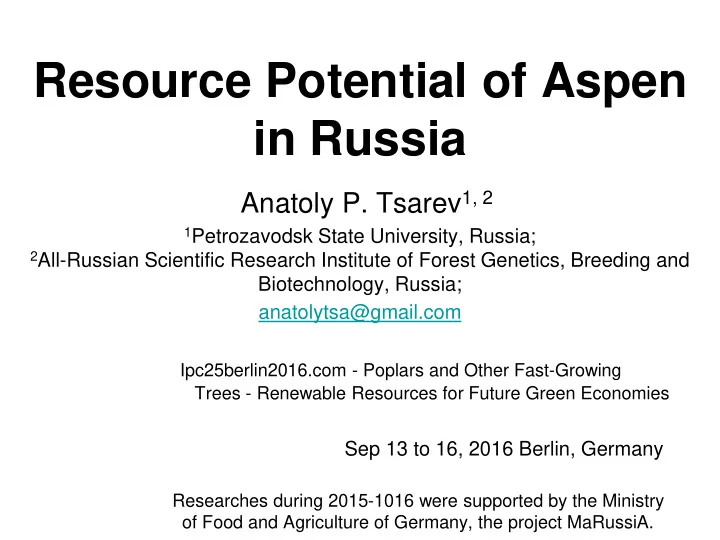

Resource Potential of Aspen in Russia Anatoly P. Tsarev 1, 2 1 Petrozavodsk State University, Russia; 2 All-Russian Scientific Research Institute of Forest Genetics, Breeding and Biotechnology, Russia; anatolytsa@gmail.com Ipc25berlin2016.com - Poplars and Other Fast-Growing Trees - Renewable Resources for Future Green Economies Sep 13 to 16, 2016 Berlin, Germany Researches during 2015-1016 were supported by the Ministry of Food and Agriculture of Germany, the project MaRussiA.
Weed - this is plant which useful properties we have not yet learned to use(R. Emerson)
• Aspen is one of forest-forming species in Russia. • Its natural forests grow fast, have considerable volumes in stem wood and favorable straightness of the stems. • This species is sufficiently unpretentious to growing conditions and shows excellent regeneration. • Wood of aspen is white, odorless, easily workable and can be used in a wide range of applications. • It therefore has significant resource potential. • A limitation to aspen domestication is heart rot. • The causative agent of this illness is mushroom Fellinus tremulae Bond. et Boriss. ( Fomes igniarius f. tremulae Bond.).
• Because of that, aspen is regarded by foresters as an unwanted species . • Many of the recommendations for forest management aim to reducing its area or complete elimination. • Despite these recommendations, prohibitions and ongoing measures, the area of aspen distribution in Russia since 1956 has increased on 73 % and reached more then 24 million hectares presently.
• At the same time, especially in recent decades, a growing number of researchers came to the conclusion that aspen is a useful species, and we have to learn to improve its resistance to phytopathogens. (A. Yablokov, M. Veresin, S. Ivannikov, V. Bakulin, B. Vladimirov, L. Mikhailov, Y. Smilga e. a.). • Improvement of this species includes breeding, selection, introduction, hybridization, polyploidisation, transgenesis etc. • The results described in this report were obtained in the Central Chernozem region of Russia, using selection and hybridization
– – Selection . • The investigation of natural aspen stands was carried out in massifs of the Voronezh region. • These massifs are located on the border of forest-steppe and steppe zones. • The latitude is 51-52º of North and 39-42º of East. • The total area of investigated aspen forests in accounts for over 17 thousand hectares. • It was selected some plus stands.
In General, selection conducted in the Central Chernozem region allowed to identify high-value plus stands, which in the age of maturity in C 2 environmental sites were: stand quality class - Iª-I b ; the stock of wood in 45 years with completeness equal to 1.0 to 340-490 m³/ha; the number of affected trees with fruit bodies did not exceed 6%. While in usual stands in similar conditions at the same age the number of infected stems ranged from 20 to 90%. The yield of the sound wood at the best stands were 67-75%, while in the normal ones is varied from 2 to 17%.
Some variants of aspen hybrids obtained and investigated in Central Chernozem region Intersectional hybrids of aspen and white poplars – P. alba x P. tremula (M. Veresin) – P. alba x P. tremula – 78. Б .35 (A. Tsarev) – P. tremula x P. alba (M. Veresin) – P. davidiana x P. bolleana-06-24 (V. Petrukhnov) – P. tremula x P. с anescens-47-08 (V. Petrukhnov) – P. ‘Yablokovy’ х P.tremula-38-06 (V. Petrukhnov) – Other. Intrasection aspen hybrids – P.tremula x P. tremula-44-08 (V. Petrukhnov) – P. tremula x P. tremula-48-09 (V. Petrukhnov) – P. tremuloides x P.tremula-14-07 (V. Petrukhnov) – P. davidiana x P.tremula-21-09 (V. Petrukhnov) – Other.
• In terms of growth and absence of any injuries and diseases in some collection of hybrids selected over 60 promising hybrids, the height of which at 29 years of age ranged from 19 to 25 m, average diameter from 25 to 40 cm, trunk volume from 0.4 to 1.1 m³. • Thus, by growing new aspen hybrids in the Central chernozem region the supplies of wood may be 300 - 500 m³/ha already to 30 years old of stands. • The next stage of hybridization – factorial crossbreeding initiated in the 2015-2016 years.
Height ( numerator, cm ) and quantity ( denominator, examples ) of aspen hybrid seedlings at 15.08.2016 ♀ ♂ Free pollinat ion, Mean /∑ 07-02 08-02 32-03 45-03 48-02 Mean /∑ 02-01 0 40/22 0 15/1 0 28/23 15/29 10-03 39/7 16/141 34/10 28/66 32/21 30/245 19/219 18-02 35/2 18/98 33/59 30/45 24/15 28/219 6/186 23-05 23/9 30/24 10/4 30/26 0 23/63 15/158 45-01 0 34/32 0 31/3 22/31 29/66 5/276 Total 32/18 28/317 26/73 27/141 26/67 28/616 12/868
Aspen hybrid family 02- 01 х 08 -02 25.07.2016
Conclusion . • The results show that the selection and hybridization may give fast-growing hybrids, which can produce of stem volume wood faster than the development of the disease. • This rapid growth of plants or any other factors contributing to their resistance to fungal diseases, the purposeful work, the economy can obtain valuable plantations, resistant to the main beach aspen – the heart rot of the wood. • Overall, aspen is a valuable resource of wood and other useful properties. Rational use of this aspen potential could make an important contribution to the transformation of forestry in a highly profitable industry.
Thank you very much for your attention!
Recommend
More recommend